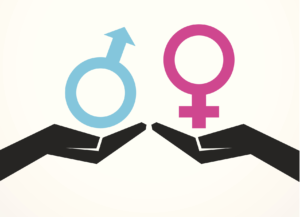Heteronormativity.
It’s a long and academic-sounding word, but it’s pushed its way into public conversation recently. And like many other jargon-y words that surround queer theory, the concept is a little bit hard to get a grasp on. But it serves an extremely important purpose when dissecting the world around us!
And that’s because this word touches on something deeply important to understanding queer and feminist issues – and that’s why it’s worth breaking down for folks who still aren’t comfortable with it.
It’s especially important to understand heteronormativity if you live a life that contradicts the expectations of a heteronormative society.
Queer folks, trans folks, and folks of color are inherently outside of the demands of heteronormativity. So, knowing how to recognize these societal pressures as “heteronormativity” is a wonderful way of knowing why you feel “outside” of certain parts of society.
Plus, once you know the rules, it’s so much more fun to break them.
So, what do I mean when I say “heteronormativity?”
Well, let’s say you’re out at a bar. A friend of yours sees a cute guy, but she’s hesitant to make the first move because she assumes the guy would be turned off by that – because we’re socialized to believe that women shouldn’t approach men like that, lest they come off as desperate. That’s heteronormativity.
When she finally gets the courage to go up and talk to him, he begins to call her infantilizing pet names (like honey, baby, and sweetheart) – which would be fine if they’d agreed upon it, but he’s just assuming she’s cool with it! That’s heteronormativity.
When she begins to get uncomfortable by these names, she gets up and leaves. But the guy says something like, “Oh, come on! Women are so sensitive. What’s your problem?” That’s heteronormativity.
Heteronormativity, then, is a system that works to normalize behaviors and societal expectations that are tied to the presumption of heterosexuality and an adherence to a strict gender binary.
And while it may seem vague and hard to pin down, once you start to recognize heteronormativity, you’ll start to see it everywhere
And to help you start to recognize it, let’s talk about these four ways that it shows up – in your life and in your feminism.
1. The Gender Binary
The gender binary is a term used to describe the practice of only recognizing two distinct genders.
More simply, the gender binary is the acknowledgement of the existence of men and women (and boys and girls) – and nothing else.
And the gender binary is vital to a system of heteronormativity.
Because it’s the creation of two opposing, seemingly completely separate genders that keeps heteronormativity afloat.
It’s much easier to say that men are more capable of controlling the public sphere (like politics or business) and women are more suited for the private sphere (like raising children, cooking, and cleaning) when you have a strict division of gender (men versus women).
But that hierarchy is hard to accept as “normal” when you step outside of that binary. Thus, the gender binary is used as a serving dish to hold all of the gendered expectations that heteronormativity demands of us.
In this way, being on one end of the gender binary or the other (and performing those genders “properly”) is a standard that queer folks and folks from cultures that don’t recognize this binary are “failing” to reach.
You deviate from this heteronormative standard by being non-binary, or even simply performing gender in a way that doesn’t subscribe to a strict separation of “man” or “woman” (and the assumption that “masculinity” should only be performed by the former and “femininity” by the latter).
For example, I fail at this expectation of heteronormativity simply by being non-binary.
And this visibly plays itself out in a variety of ways: I rejected the gender I was assigned at birth. I’m a gender that falls outside “boy” or “girl,” which single-handedly destroys the concept of a binary. Further, I deviate from my assigned gender by not shaving my legs, shaving my head, not being sexually or romantically interested in men, and not waxing my unibrow or shaving the hair that grows on my neck
The perpetuation of a gender binary only serves to uphold heteronormativity. So when you see people subscribing to this idea (which, um, is all around you, all the time), then you’ve got yourself a clear-cut example of heteronormativity!
2. Patriarchal Gender Roles
Patriarchal gender roles are all of the things we expect from men and what we expect from women, for no other reason than that they are a man or a woman.
(And if you were paying close attention in the last section, you’ll notice here that the gender binary plays an important role in many other standards of heteronormativity, like this one. Because we can’t have gendered expectations unless we rely on the existence of a gender binary!)
For instance, the idea that men love sports and women love getting their nails done (but that women don’t like sports and men don’t like getting their nails done) is a gendered expectation based on the gender binary.
The idea that boys like trucks and girls like princesses (but that boys don’t like princesses and girls don’t like trucks) is a gendered expectation. And worse, it’s one that toy companies use to sell more toys. (But more on how capitalism fits into all of this another day!)
These expectations dictate so much of the way that life is structured in hetero-dominated societies like ours.
This is the color blanket that they put on you at the hospital, this is the field you feel like you should study in college, the leisure activities you enjoy.
The problem is that so few people feel the need to question these standards, so they get passed off as what’s just “normal” or what’s “natural” – seemingly solidifying them in our social consciousness as objective“truth.”
And that is the essence of heteronormativity – that these things are completely normalized, leaving all of those who don’t meet these expectations marked “abnormal” or “unnatural.”
These expectations also dictate how you interact (or are “meant” to interact) with other people. These “scripts” for social interactions rely heavily on whether you’re a man or a woman and whether you’re interacting with a man or a woman (here’s that pesky little gender binary again).
Heteronormativity is what tells you who is supposed to pay for dinner when you’re out – and who cooks dinner when you’re at home.
It tells you that men are supposed to make the most money, which impacts who gets hired and how much they get paid.
It tells you that no matter how much you love your partner, that you’ll just “never understand women” or “never understand men.” (Men Are from Mars, Women Are from Venus, anyone?)
It tells you that women are nagging and that men are insensitive.
The system of heteronormativity informs what we expect from men and what we expect from women – and we perpetuate that system when we police those behaviors accordingly.
Queer people, then (as well as any other folks who don’t strive to meet these standards), disrupt heteronormativity by throwing away the script.
3. Monogamy
In a heteronormative society, relationships exist on a hierarchy.
Gayle Rubin explains this hierarchy through “The Charmed Circle” in her piece “Thinking Sex: Notes for a Radical Theory of the Politics of Sexuality”.
This circle positions middle class and wealthy, cisgender, heterosexual, married, monogamous couples who have reproductive sex at the center.
This is the standard expectation that all adult relationships are held up to, and each step you take away from that center, the less your relationships is deemed valuable by a heteronormative society.
For example, non-married, monogamous, heterosexual couples having non-reproductive sex takes two steps away from the center – because they are neither married nor having reproductive sex, which is the standard.
Multiple partners in polyamorous relationship who are queer, non-married, and having non-reproductive sex, takes a few more steps back from the standard –making these relationships less and less desirable in a heteronormative society.
This is exactly the reason why modern Gay Rights Movements™ seek rights through marriage – to gain access to higher rungs on this relationship hierarchy by meeting certain expectations of heteronormativity.
Since marriage as an institution and a hierarchy have been so normalized through heteronormativity, most people don’t even question the fact that so many rights are held above our heads and given away as prizes to those who (can and choose to) assimilate.
This is why Gay Marriage™ is seen as a perfectly progressive way to gain access to rights. But these rights are still denied to folks who fall outside of the charmed circle in certain ways (queer folks are more associated with non-reproductive sex, for example, or non-heterosexual coupling).
The only people who benefit from Gay Marriage™ are those who already hold positions closer to the center of the circle anyway (like being middle class or wealthy, monogamous, and cisgender).
Queer politics that resist heteronormativity instead call for an abolition of state-sanctioned monogamy, and demand that the benefits given to married couples should be given to all people, regardless of their relationship status.
Which just goes to show that heteronormativity shows up even in politics that feel feminist.
4. White Supremacy
When we talk about heteronormativity, we need to acknowledge the ways in which heteronormativity is racialized. That is, a key element of heteronormativity is meeting standards of whiteness.
Every patriarchal gender role, the normalization of the gender binary, and the institution of state-sanctioned monogamy (marriage) has been used as a tool of white supremacy (or, to put it another way, as a tool to oppress people of color).
In this way, heteronormativity actively benefits white folks in ways that it devalues the lives of people of color.
Keeping benefits tucked beneath marriage certificates has historically allowed governments to withhold benefits to black folks and other people of color who were not allowed to marry, or have their marriages or relationships recognized in the same way.
The gender binary was and is used as a tool of colonial violence, as it erases and denies the existence of non-white, non-binary identities.
In fact, imposing a Western European gender binary was (and is) a major part of forced assimilation (forcing native people to adopt the culture of the people colonizing their land). Male dominance (white male dominance in particular) was and is a major driving force in imperialism and colonialism.
But it’s hard to convince people of male dominance without the strict gender binary I mentioned earlier.
So instilling this binary becomes a major part of the violence settlers inflict upon the people they colonize, making heteronormativity a big part of white supremacy.
(Check out all of these awesome non-binary genders from around the world that have survived and resist Western understandings of the gender binary.)
Even the gender roles that we’re pressured to perform are based on very white depictions of gender!
Where white men are expected to be breadwinners and moneymakers, black men are expected to be lazy criminals and absent fathers. While white women are expected to be innocent, frivolous, and in need of being saved, black women are seen as hypersexual, loud, “masculine,” and immune to pain.
When heteronormativity is tied to white supremacy, we perpetuate the latter when we do the former, leaving people of color in positions of never being able to “win” the game we’ve set up.
And if we want to fight against heteronormativity, it’s necessary that we also view it as it is – highly racialized – and realize that any real battles against heteronormativity must also be actively against racism.
***
It is okay to feel overwhelmed by these long and jargon-y words, but it’s important to be able to recognize when things like heteronormativity are actively playing a part in your life and the lives of those around you.
So, start to look out for ways in which your behaviors and interactions are governed by the invisible hands of heteronormativity.
Because once you can recognize it, you can start resisting it.
[do_widget id=’text-101′]
Kris Nelson is a Contributing Writer for Everyday Feminism. They run a blog full of short queer-centric radical prose, which can be found at thequeertimes.tumblr.com and a poetry blog that can be found at songswithoutlyrics.tumblr.com. Kris also runs an online store by the name of Spell-Bound, where they sell handcrafted wire work jewelry, crystal pendants, hand sewn tarot bags, and pendulums. They can be contacted at [email protected] and trans-witch.tumblr.com.
Search our 3000+ articles!
Read our articles about:
Our online racial justice training
Used by hundreds of universities, non-profits, and businesses.
Click to learn more





















